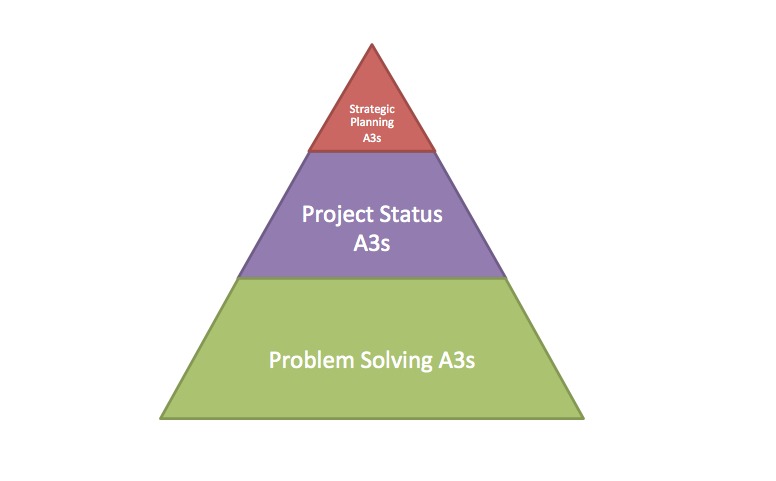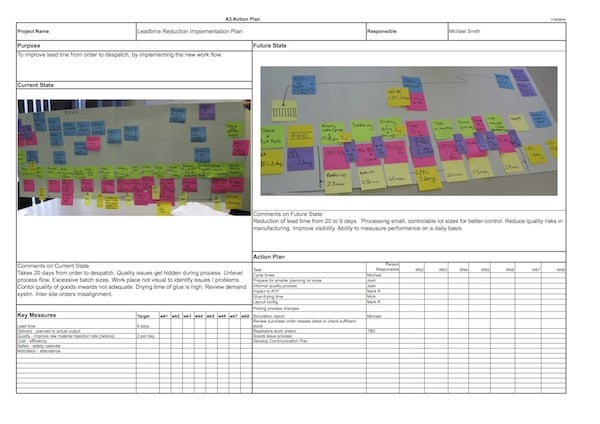If you’ve been hanging around the lean community for a while, no doubt you will have come across the concept on an “A3 Plan”.
Today we will look at what an A3 is and look at the different types of A3, to clarify which type you would use when – it can be a little confusing at the beginning.
What is A3?
An A3 is simply a paper size (420mm x 297mm) but what an A3 plan represents in the lean and business community is the ability to put a plan onto one sheet of paper and use this one sheet of paper to communicate the intent of the plan, along with the current status.
With any lean approach, we are using the A3 plan to define the current state – where are we now?, the future state – where do we need to be? and the gap – the difference between the current and future states. We then need to highlight what we are going to do to close that gap and how are we going to measure and track our success.
This is done in parallel to our Plan-Do-Check-Act thinking. the A3 plan isn’t only the Plan part, it is used to track the doing and checking, and adjusted as necessary during the Act or Adjust phase.
Types of A3 Plans and Methodologies Explained
There are three main types of A3 plans
1. Strategic Planning A3
2. Project Status A3
3. Problem Solving A3
The number of A3 types and their actual names will vary between companies and industries. For the sake of simplicity here will will focus on the main three. The key here is to understand that there are different applications for the A3 plan.
Strategic Planning A3
This is the type of planning done at the senior leadership level of a company and is the overarching A3 plan. We want to use this type of A3 planning when the future state is in the medium to long term future – often 12 months or more.
When starting out on your lean journey, this timeframe may start with a 6 month scope.
This high level of A3 plan still needs to follow the PDCA cycle. At this level the Check step is critical. Clear metrics need to be defined in the beginning so everyone understands what measures are important and how they will be collected and used. this will determine how the “success” of the project is perceived.
Project Status A3
Many action steps are needed to complete the strategic planning A3 and these individual actions are broken out into Project A3s, allowing each area or process owner the have their piece of the overall strategic plan.
The key here is to make sure the scope is in agreement with the top level plan, and the metrics are a clean subset of the strategic ones. The best way to plan for success with a project A3 is to have complete alignment.
Problem Solving A3
The problem solving A3 plan allows us to work through a problem. The aim is to get as much information and input from those involved in the process as possible to fully define what the problem actually is – without agreement as to the actual problem you are trying to solve, it will be very hard to get a consensus that the set of solutions you are going to trial and implement will actually solve that problems.
Note I said “set of solutions you are going to trial and implement” – problem solving needs to be viewed as a series of trials. Our traditional problem solving methods is for the loudest person in the room to declare what to do and then the smart ones have to try to get this “solution” to work; it is a HUGE waste of time, energy and resources. Having a true team problem solving approach will take time to develop but will provide better problem solving in the long run. Use the Problem Solving A3 plan to document the key inputs and trials being conducted to find a set of solutions.
Creating an A3 Project Plan That Works For Lean
One of the delightful parts of being a Lean consultant and working the amazing companies that we do, is watching the process unfold as we explore what their companies might look like with a Lean enterprise approach. We talk about the importance to taking a “value stream map” approach and create a future state that embraces all that is good in the place and adds in the elements to make it great.
Then we identify the key projects needed to close the gap between the current state and where we want to be with the future state. The top five or six projects need to be identified so we can concentrate the initial implementation efforts on a several key areas. Use the value stream map to guide you on the project selection. And use the map to communicate how the current and future projects relate to our “Big Picture” improvement journey.
While there are many assessment tools and criteria, don’t make it too complicated – just pick the ones with the most passion to get started while enthusiasm is running high!
Creating the REAL A3 plan is the next step – this is the one that helps and guide us to getting stuff done! Firstly create the top level A3 implementation plan, using the value stream maps to highlight the current and future states, noting the measure that will tell us if we are doing a good job. Then list the projects as the first round of Action Steps. To really engage your Lean Implementation Team, have each person adopt a project; something they are passionate about and is within their current abilities to achieve. Then help each team member to create the own, tier 2 A3 plan.
A heightened level of excitement and importance can be achieved by having a presentation to senior management, outlining the overall findings during the value stream mapping sessions and reviewing the first drafts of the A3 plans. This session can also be used as a milestone review, getting broad agreement that your team is on the right track.
Then the hard work begins – taking the plan and implementing it; trialling, experimenting and learning form the process. That is where the real improvements are made!









